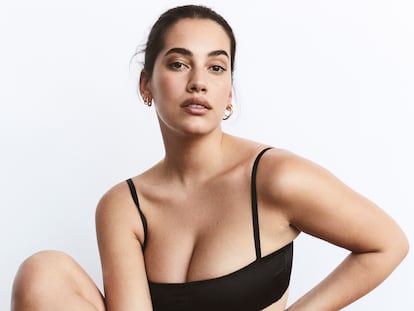The anxiety of the fitting room: ‘Who are these sizes for?’
As extreme thinness returns to the catwalk, many women find buying clothes to be an increasingly traumatic experience, leading them to decry the lack of variety in sizing


Ten girls wait impatiently to enter the fitting room of a well-known fast-fashion store in downtown Madrid. It’s 7:30 p.m. on a spring Saturday, peak weekend shopping time. They endure oppressive heat as they wait in line, holding several items of clothing in their arms. “I don’t know why I’m going in; I’m sure nothing will fit me,” says one of them. They ask their mother for advice to make sure that what the mirror tells them about the garments they’re trying on is true. The harsh light of the dressing room reveals every inch of skin and mercilessly shows how the garment fits to the last centimeter of their bodies. When they leave, most of them return all the clothes they had considered buying to the salesclerk. They ultimately discard these pieces because their usual size no longer fits — the XL trendy top does not cover their chest, or the jeans fit at the hips but are loose in the thighs. There are myriad reasons that turn the process of shopping for clothes into a bad experience for many people, especially women.
That scene is repeated in many stores. Shop windows are all dominated by scrawny mannequins, none of whom are plus-sized, sporting colorful designs reminiscent of early 2000s styles: low-slung jeans and skirts, short tops, tight mini dresses, cargo pants. Away from the hustle and bustle of the stores, remarkably skinny models parade on catwalks once again, as they did in the 1990s. The aesthetics of extreme thinness — heroin chic fashion — is back, and many celebrities and influencers, including erstwhile curvy icon Kim Kardashian, are losing weight. In practice, the size revolution and inclusivity have not quite taken hold. Amid all these trends, hundreds of young people decry the fact that shopping and facing the fitting room are increasingly difficult ordeals.
“Being in a store, especially a fast fashion store, itself is already an anxiety-inducing process,” explains Ester Silva, a psychologist who specializes in eating disorders and takes a gender perspective. Some of the factors that lead to stress inside stores include long lines, constant motion and fitting-room curtains that don’t close properly so someone can see us from outside. “But inside the fitting room, the experience is amplified. White lights illuminate every inch of skin, mirrors focus on parts of our bodies from perspectives that we’re not used to seeing. It is a space that emphasizes exposure, and this amplification provokes a magnifying glass effect in our minds, which leads us to thoroughly analyze our bodies,” the psychologist continues.
This meticulous examination of our bodies is difficult to digest. It can lead to self-image problems, which Silva defines as an obsessive or excessive concern about some part of our bodies that, while practically imperceptible, occupies a lot of space and time in our minds and can generate anxiety, depression and social isolation. Silva believes the problem begins before even setting foot on the premises. “It is necessary to look at the function of going shopping. Many times, we go just because we need momentary gratification, something to make us feel better. But these expectations are not easy to meet, which increases the risk that the results will be harmful,” she says.
Some women don’t even harbor hope. “It’s totally impossible to find more than a size 44 in a physical store,” says Marta Camín, a stylist, curvy model and fashion content creator. However, many stores do have plus sizes on their websites or shopping apps, and there are brands that specialize in plus sizes, although sometimes their prices are higher. Many physical stores do not meet the goal of diversity, although some are better than others.
The debate over the lack of diverse sizing and different measurements among brands transcends the individual. On the terrace of a bar in Madrid’s Lavapiés district, Mar Gadea, 25, talks with several friends about how distressing it is for her to go shopping. She says she prefers to buy clothes online to avoid the ordeal of trying clothing on in the fitting room. “But then,” she says, visibly indignant, “if all of us here have different bodies and none of us fit, who are the sizes for?” Alba del Campo, 30, from Bilbao, recognizes herself in these young women’s stress: “The mirrors are horrible, the image you see is totally distorted. Sometimes that can make you buy things that don’t really fit you, or vice versa. You get home and you think, ‘Where is what I saw in the fitting room?”
One only needs to search for “Zara and sizes” on TikTok to see dozens of videos of women in fitting rooms, showing how the smallest size is too big or the largest size does not fit. The multinational fashion company says that it’s committed to diversity: “We work to offer a wide range of sizes and designs in our brands’ products.” For example, Zara’s denim line offers sizes between 32 and 46. “Our goal is to continue to constantly improve in this regard…We pay close attention to feedback from our customers,” they say.
One possible explanation for this phenomenon is the companies’ shift toward gradually standardizing sizing. “Before, we normally size 32 to 46 in a store. Now, the trend is increasingly towards S, M, L and XL. We’ve gone from eight sizes to four,” Camín explains. “The old 32 is now a small, which spans several sizes, so it’s too big for some people. And the medium has to become smaller to accommodate the people the small [size] doesn’t fit.” And so on and so forth. The main reason for doing this is that fast fashion brands save money by designing only four patterns as opposed to, say, eight, Camín explains. “Patternmaking is the most expensive part of making clothes, not the fabric itself. And it’s much easier to design [clothing] for a smaller size than [for] a bigger one,” she argues.
But this general frustration isn’t only the result of changes in sizing, sizing differences between brands or even at the same store. Social media influence also plays a key role. At the end of 2022, an audio of model Bella Hadid — whom many young people consider to be the top model of her era — went viral on TikTok. Many users invoked the recording to talk about her restrictive diets and praise extreme thinness in a veiled way. Meanwhile, celebrities show off their bodies, which are slimmer than ever before, on their Instagram stories. Silva explains that this creates a mirror effect: “We focus on individually improving a [flaw] that has been created for us [but] is not real. Before, we were only exposed to what they showed on TV [and] mannequins. Now, repeatedly seeing these ‘perfect’ images makes us obsessed with meeting the standards to which we are exposed.”
Some stores have advertised collections with images of plus-size models, but then the clothes don’t fit different body types well. “That’s not being inclusive. It’s putting it on the cover to look good,” explains Camín. She notes that at this year’s New York Fashion Week, of the more than 2,500 models, only 200 were curvy. “Now there are at least 200, but that’s still a very low number. You have to aim for more,” says the content creator. In practice, however, it is more complicated. It is not profitable for the fashion industry to increase sizes or stock. Practically everything seen on the catwalk ends up in stores, including the idealization of thinness. “Fashion reflects today’s society and what it’s going to be. And people are obsessed with being thin,” Camín notes.
One possible solution is demanding that the big brands use a universal sizing table for all stores and offer patterns that are closer to women’s real bodies. Camín explains that it is difficult to standardize patternmaking criteria, from manufacturing to differences between younger and older people. Camín points out that “the target public prefers the illusion of looking slim to… wearing a larger size. We’re not going to get a brand to make sizes for everyone; they’re not going to shell out that kind of money. What we can do is raise awareness that it’s okay to wear a 44. Being fat is not bad, being skinny is not bad, being average is not bad,” she continues. The stylist also stresses the importance of asking for specialty stores. “The problem is that it’s stigmatized. You have to be proud to go to a plus size store, because it’s just that, a size,” she concludes.
Fitting room design is already changing in some stores because they have recognized the importance of improving customer experience. They are starting to install adjustable lighting and movable mirrors. “They are humanizing the process. The salesclerk introduces herself, asks for your name to write it down. Before it was [a] colder [experience],” says Del Campo.
There is still the matter of how to handle leaving the store, sometimes without a purchase. Silva recommends being careful about exposure and avoiding it at all costs if fashion affects us on a psychological level. “We have to be introspective, know [where] we are and whether it’s a good idea to go to these places where we’re exposed, like fitting rooms and on social media,” she avers. Del Campo, who specializes in personal and corporate image consulting, also advocates using social media responsibly: “We have to do it by viewing diverse content, for example, by consciously and actively seeking out plus-size models we like, because if we only consume videos or photos of very thin people, that’s all the algorithm shows us.” Of course, we must also detach the body from the purely aesthetic and understand that it has other more important functions.
Sign up for our weekly newsletter to get more English-language news coverage from EL PAÍS USA Edition
Tu suscripción se está usando en otro dispositivo
¿Quieres añadir otro usuario a tu suscripción?
Si continúas leyendo en este dispositivo, no se podrá leer en el otro.
FlechaTu suscripción se está usando en otro dispositivo y solo puedes acceder a EL PAÍS desde un dispositivo a la vez.
Si quieres compartir tu cuenta, cambia tu suscripción a la modalidad Premium, así podrás añadir otro usuario. Cada uno accederá con su propia cuenta de email, lo que os permitirá personalizar vuestra experiencia en EL PAÍS.
¿Tienes una suscripción de empresa? Accede aquí para contratar más cuentas.
En el caso de no saber quién está usando tu cuenta, te recomendamos cambiar tu contraseña aquí.
Si decides continuar compartiendo tu cuenta, este mensaje se mostrará en tu dispositivo y en el de la otra persona que está usando tu cuenta de forma indefinida, afectando a tu experiencia de lectura. Puedes consultar aquí los términos y condiciones de la suscripción digital.
More information
Archived In
Últimas noticias
Welcome to the post-religion era: The idea of Christianity as the absolute truth has become obsolete
‘I thought you would like it’: The risky sexual practice popularized by TV shows and TikTok
The digitalization of tourism: ‘They promise experiences and gave us the worst possible one’
Mexican peso defies uncertainty with forecasts of a new period of stability in 2026
Most viewed
- Sinaloa Cartel war is taking its toll on Los Chapitos
- Oona Chaplin: ‘I told James Cameron that I was living in a treehouse and starting a permaculture project with a friend’
- Reinhard Genzel, Nobel laureate in physics: ‘One-minute videos will never give you the truth’
- Why the price of coffee has skyrocketed: from Brazilian plantations to specialty coffee houses
- Silver prices are going crazy: This is what’s fueling the rally










































